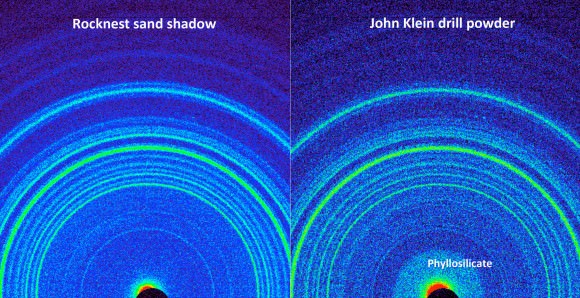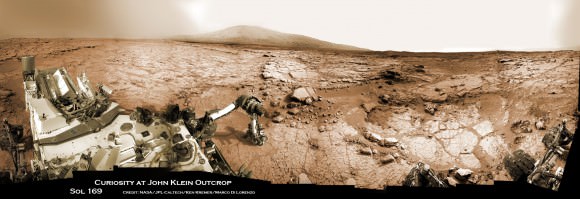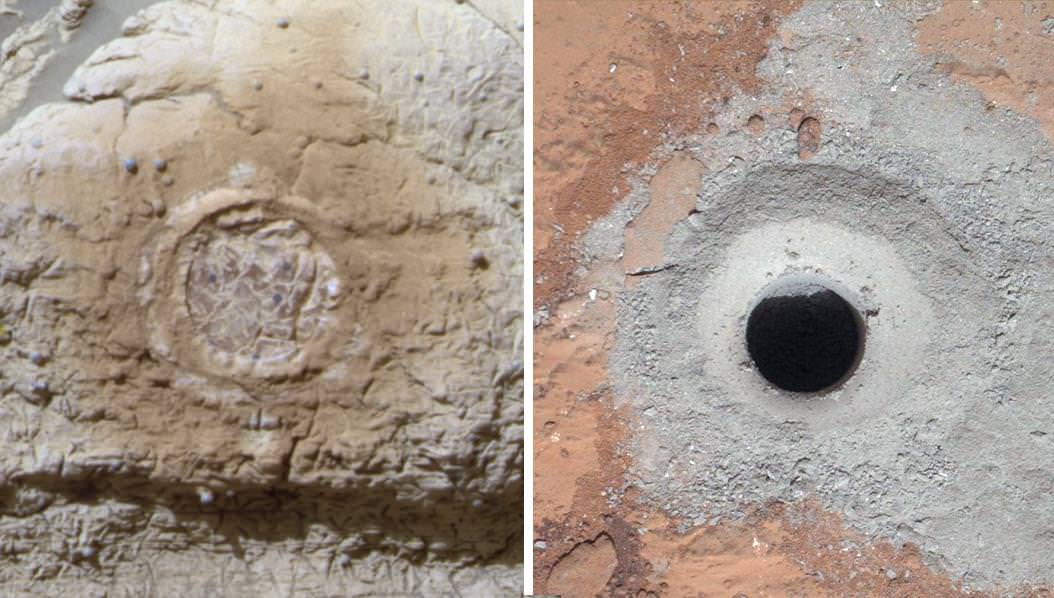After analyzing the first powder ever drilled from the interior of a Martian rock, NASA’s Curiosity rover discovered some of the key chemical ingredients necessary for life to have thrived on early Mars billions of years ago.
Curiosity has achieved her goal of discovering a habitable environment on the Red Planet, mission scientists reported today at a briefing held at NASA headquarters in Washington, D.C.
Data collected by Curiosity’s two analytical chemistry labs (SAM and CheMin) confirm that the gray powder collected from inside the sedimentary rock where the rover is exploring – near an ancient Martian stream bed – possesses a significant amount of phyllosilicate clay minerals; indicating an environment where Martian microbes could once have thrived in the distant past.
“We have found a habitable environment which is so benign and supportive of life that probably if this water was around, and you had been on the planet, you would have been able to drink it,” said John Grotzinger, the chief scientist for the Curiosity Mars Science Laboratory mission at the California Institute of Technology in Pasadena, Calif.
Curiosity cored the rocky sample from a fine-grained, sedimentary outcrop named “John Klein” inside a shallow basin named Yellowknife Bay, and delivered pulverized powered to the Sample Analysis at Mars (SAM) and Chemistry and Mineralogy (CheMin) instruments inside the robot.
The presence of abundant phyllosilicate clay minerals in the John Klein drill powder indicates a fresh water environment. Further evidence derives from the veiny sedimentary bedrock shot through with calcium sulfate mineral veins that form in a neutral to mildly alkaline pH environment.

“Clay minerals make up at least 20 percent of the composition of this sample,” said David Blake, principal investigator for the CheMin instrument at NASA’s Ames Research Center in Moffett Field, Calif.
The rovers 7 foot (2.1 meter) long robotic arm fed aspirin sized samples of the gray, pulverized powder into the miniaturized CheMin SAM analytical instruments on Feb. 22 and 23, or Sols 195 and 196. The samples were analyzed on Sol 200.
Scientists were able to identify carbon, hydrogen, oxygen, nitrogen, sulfur and phosphorus in the sample – all of which are essential constituents for life as we know it based on organic molecules.
“The range of chemical ingredients we have identified in the sample is impressive, and it suggests pairings such as sulfates and sulfides that indicate a possible chemical energy source for micro-organisms,” said Paul Mahaffy, principal investigator of the SAM suite of instruments at NASA’s Goddard Space Flight Center in Greenbelt, Md.

The discovery of phyllosilicates on the floor of Gale crater was unexpected and has delighted the scientists. Based on spectral observations from Mars orbit. Grotzinger told me previously that phyllosilicates had only been detected in the lower reaches of Mount Sharp, the 3 mile (5 km) high mountain that is Curiosity’s ultimate destination.
Grotzinger said today that Curiosity will remain in the Yellowknife Bay area for several additional weeks or months to fully characterize the area. The rover will also conduct at least one more drilling campaign to try and replicate the results, check for organic molecules and search for new discoveries.


The ‘precious’ flow of data from Mars … amazes and astounds! Lets take a walk….on MARS!
Exciting news! Once again, Curiosity scores big!
My question is how old do we think these deposits are? If the Gale crater is 3.8 billion years old, wouldn’t these deposits be older? Does that give life enough time to begin if Mars lost its magnetic field 4 billion years ago?
I have a similar question. If simple mammalian life did indeed ever exist on Mars how likely is it that any remnant might be found / identified? In other words, has so much time passed that it would nearly impossible to find intact evidence even it there had been life?
Depends.
The oldest bacterial fossils on Earth are now ~ 3.7 billion years old, improved technique have just placed the so called Isua banded iron formations as most likely deposited during early (non-oxygenating) photosynthesis. We will have to see if that is accepted, the heating (metamorphosis) of those sediments have been a showstopper before.
If not, there are ~ 3.5 billion year old finds that are considered unambiguous today.
The oldest eukaryote fossils are specific so called steranes, remnants of eukaryote specific compounds called sterols, and they are some 2 billion years old. So there is hope, depending on Gale’s age.
Mammalian life (“the most recent common ancestor of living monotremes (echidnas and platypuses) and therian mammals (marsupials and placentals)”, Wikipedia) is highly unlikely since biology doesn’t easily repeat itself.
Complex multicellular and mobile life forms could evolve on old enough worlds, but for energetic reasons it is believed the atmosphere needs to become oxygenated first. That didn’t have time to happen on Mars, it lost its atmosphere and so its surface habitability too early.
ok, thank you.
I don’t think Gale has been precisely dated, but it seems earlier datings (of at least 2.5 billion years) are supported or even pushed further back.
My understanding:
The bedrock of the crater floor would be the oldest feature, these stream bed deposits younger.
Curiosity’s finds point to habitability and enough atmosphere for running water, whether or not a magnetic field was present at the time.
Well, that’s helpful, although the only references to dating the crater state that it is between 3.8-3.5 billion years old (http://themis.mars.asu.edu/feature/22), but I certainly didn’t look in any academic journals. I hadn’t heard that it was younger. I was also mistakenly thinking that the impact had exposed the layers that Curiosity was examining and hadn’t thought about the fact that it was later deposits.
It would be great if scientists could get a more clear picture as to how old the deposits were.
How is opportunity these days?…
Isn’t anyone getting tired of the same old theme of, ‘if’, ‘may’, ‘possibly’, ‘could have’, etc etc etc, after all the decades and trillions? spent, it still seems like a guessing game, don’t get me wrong, I LOVE the technogical drive, always have since childhood, but since childhood we appear to be no closer to any definitive answers, I can feel my scientific curiosity turning into scientific aphathy 🙁
Those *are* many times definitive answers, tested beyond reasonable doubt, but the quantifiers signify that there is always uncertainty, remaining (or new) alternate theories, et cetera.
You have to check the source to separate what is is till open questions and what is no longer uncertain (or even rarer “guessing”, ad hoc hypotheses). But to do that legwork means being curious about these questions, and humoring that curiosity, naturally. Curiosity, like play, needs nurturing.
I have follow Curiosity for 2 months and I see many incredible thing that it made. I’m so excited to next goal
“Scientists identified sulfur, nitrogen, hydrogen, oxygen, phosphorus and carbon …
The rock is made up of a fine-grained mudstone containing clay minerals, sulfate minerals and other chemicals. … “Clay minerals make up at least 20 percent of the composition of this sample,” said David Blake, …
The presence of calcium sulfate along with the clay suggests the soil is neutral or mildly alkaline. … Scientists were surprised to find a mixture of oxidized, less-oxidized, and even non-oxidized chemicals, providing an energy gradient of the sort many microbes on Earth exploit to live. ”
Ah, the necessary CHNOPS suite (Carbon, Hydrogen, et cetera) that is the major constituents of cells!
But no certified organics (“other chemicals”) as of yet, even if the stream bedding suggests an excellent sediment trap.
The upshot is that a) the then environment was perfectly habitable, b) the now environment can preserve organics (not fully oxidized) and is _still_ perfectly habitable as regards CHNOPS and energy (just add water).
Other news yesterday was that scientists have found that bacteria that live in extremely dry conditions (say, saline) has a chemical trick to retain water. Charges such as in some proteins keep the highly polarizable water from vaporizing. Auspicious press releases.
Well done Mars for hosting habitable environments (remember Phoenix too found a habitable environment at its landing site far north) and MSL et al for confirming this for us in-situ in Gale Crater. On a side note current habitability of Mars for primitive Earth life has also been confirmed by experiments in the past years here on Earth (eg alpine lichen and rock dwelling microbes not only survived Martian conditions but even thrived in those experiments).
So can we now start the search for bio-signatures (past/present) and fossils in Yellowknife Bay and surroundings – visual suggestive shapes and structures are plenty in this area.
I would suggest that, after the geologists have done their job, the astrobiologists of the MSL crews (McKay, Stoker et al) to take command and start practical exo-biology research on Mars now! 🙂
Armchair explorers can start hunting for fossils and other manifestations of past/present life in the wonderful panoramas MSL is providing for us here (teaser): http://gigapan.com/gigapans/124324/snapshots/317541
more panos here:http://gigapan.com/users/MPJ/gigapans
Do not forget to switch to fullscreen while zooming trough the Martian environment! 🙂
If astrobiologists don’t expect to find life that way, why should “armchair explorers”? To suggest that is only to invite arduous and more importantly confusing (futile pattern search) work with little likelihood of success. Wait until there is a concerted science effort to ask for help, akin to hunting for exoplanets. I doubt that it will be forthcoming, but such efforts is a sure sign for worthwhile research.
The current environment on Mars shows many signs of aeolian instead of biological weathering, no soils and as of yet no organics. It was even hard to see that Curiosity is now inhabiting a former stream bed.
Sorry it may only be me but what was the meaning of your above posting?
What I understand is that you suggest a crowd sourcing type project initiated by “science” to search the plenty of MSL imagery for patterns which are suggestive of fossils. Good idea and until this happens why not looking at the imagery privately so to say? Do you ask “science” anytime you go into the field, enjoying nature and get the occasional fossil or otherwise interesting rock along the way? 🙂
By the way the pale blue/green “bubble mats” on the bedrock and wrapping around rocks near the John Klein drill site (Yellowknife Bay) dont look like aeolian features at all to me. If you count all the suggestive shapes and patterns in close proximity in the MSL imagery its getting really hard to keep the faith in geological coincidental features – especially after yesterdays announcement of this site being a habitable place. So I really suggest everbody who is interested to get an idea of what this place is like by themselves looking at the fantastic MSL imagery.
“why should “armchair explorers”? To suggest that is only to invite arduous and more importantly confusing (futile pattern search) work with little likelihood of success.”
Preferably one can either a) systematically identify features (Galaxy Zoo) or b) look for known patterns (Kepler public exoplanet search).
Free search may for example imply that scientists think there would be recognizable biosignatures after 4 billion years. They don’t.
Again I dont quite get the intention of your posting above. Didn’t Mr. Grotzinger himself told us that this mission is discovery driven? How to make a discovery without looking? Why doing all the Gigabytes of imaging if not to look at them? If one doesn’t look (in this case literally) one doesn’t make discoveries. So let the scientists use their precious time operating the instruments and refining useful data while the major public can look trough the images – who knows what could come along. Your initial idea of crowd-sourcing the exploratory part of the mission to aid the hard working scientists wasn’t a bad idea. I think the interested public can decide for themselves if it may be useful to look out for suspicious shapes and patterns in the imagery – the imagery is publicly available for a reason.
There is an element of logic here. Let L be “life” or the existence of biology, and let C be “conditions” or the environment appropriate for life. The logic is then
1:if L then C
2:L is found
3:therefore C.
One can think of this according to set theory. If one is in Chicago, one is then in Illinois. The data here is then analogous to saying, “We are in Illinois.”
The modus tolens of this is the counter syllogism
1:if not-C then not-L
2:not-C is found
3:therefore not-L
We can say from this counter syllogism that there is no life (or it is highly unlikely there is life) on the moon or on Venus.
It then turns out that we can’t infer the existence of life, either now or in the past, from these data so far. If one is in Illinois it does not necessarily mean you are in Chicago. You might be, but there is no inference. All that has been found so far is that conditions are commensurate with the possibility of life on Mars in the past.
LC
Theres life in Chicago, but not as we know it
One oversight common to all these comments lack is the average temperature on Mars of -60C. When I see pictorial estimates of the oceans on Mars I can only say … what are these people thinking? Is there any way the surface of Mars considering its distance from the sun – even if it somehow had half the atmosphere we do, could have had oceans of water all over the place? There is no way.
Also many people seem to think life will just spring up from a bunch of chemicals – and these aren’t even molecules ( the first step). We have not been able to create anything close to “life” under perfect conditions in a lab – on Mars, ya right!
I am happy to hear this good news